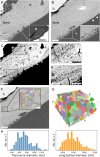Mesoscale characterization of osseointegration around an additively manufactured genistein-coated implant
- PMID: 38961115
- PMCID: PMC11222380
- DOI: 10.1038/s41598-024-66058-1
Mesoscale characterization of osseointegration around an additively manufactured genistein-coated implant
Abstract
Given the hierarchical nature of bone and bone interfaces, osseointegration, namely the formation of a direct bone-implant contact, is best evaluated using a multiscale approach. However, a trade-off exists between field of view and spatial resolution, making it challenging to image large volumes with high resolution. In this study, we combine established electron microscopy techniques to probe bone-implant interfaces at the microscale and nanoscale with plasma focused ion beam-scanning electron microscopy (PFIB-SEM) tomography to evaluate osseointegration at the mesoscale. This characterization workflow is demonstrated for bone response to an additively manufactured Ti-6Al-4V implant which combines engineered porosity to facilitate bone ingrowth and surface functionalization via genistein, a phytoestrogen, to counteract bone loss in osteoporosis. SEM demonstrated new bone formation at the implant site, including in the internal implant pores. At the nanoscale, scanning transmission electron microscopy and energy-dispersive X-ray spectroscopy confirmed the gradual nature of the bone-implant interface. By leveraging mesoscale analysis with PFIB-SEM tomography that captures large volumes of bone-implant interface with nearly nanoscale resolution, the presence of mineral ellipsoids varying in size and orientation was revealed. In addition, a well-developed lacuno-canalicular network and mineralization fronts directed both towards the implant and away from it were highlighted.
Keywords: LCN; Mineral ellipsoid; Osseointegration; PFIB-SEM tomography; Resin cast etching; Scanning transmission electron microscopy.
© 2024. The Author(s).
Conflict of interest statement
The authors declare no competing interests.
Figures






Similar articles
-
The role of titanium implant surface modification with hydroxyapatite nanoparticles in progressive early bone-implant fixation in vivo.Int J Oral Maxillofac Implants. 2009 Sep-Oct;24(5):808-16. Int J Oral Maxillofac Implants. 2009. PMID: 19865620
-
Osteoconductivity of bioactive Ti-6Al-4V implants with lattice-shaped interconnected large pores fabricated by electron beam melting.J Biomater Appl. 2021 Apr;35(9):1153-1167. doi: 10.1177/0885328220968218. Epub 2020 Oct 26. J Biomater Appl. 2021. PMID: 33106079
-
Porous PEEK improves the bone-implant interface compared to plasma-sprayed titanium coating on PEEK.Biomaterials. 2018 Dec;185:106-116. doi: 10.1016/j.biomaterials.2018.09.009. Epub 2018 Sep 13. Biomaterials. 2018. PMID: 30236838
-
Mechanical aspects of dental implants and osseointegration: A narrative review.J Mech Behav Biomed Mater. 2020 Mar;103:103574. doi: 10.1016/j.jmbbm.2019.103574. Epub 2019 Nov 30. J Mech Behav Biomed Mater. 2020. PMID: 32090904 Review.
-
Bone hierarchical organization through the lens of materials science: Present opportunities and future challenges.Bone Rep. 2024 Jun 25;22:101783. doi: 10.1016/j.bonr.2024.101783. eCollection 2024 Sep. Bone Rep. 2024. PMID: 39100913 Free PMC article. Review.
Cited by
-
Optimization of Peri-Implant Bone Repair in Estrogen-Deficient Rats on a Cafeteria Diet: The Combined Effects of Systemic Risedronate and Genistein-Functionalized Implants.Materials (Basel). 2025 Feb 2;18(3):662. doi: 10.3390/ma18030662. Materials (Basel). 2025. PMID: 39942328 Free PMC article.
References
MeSH terms
Substances
Grants and funding
- ALLRP 576146-22/Natural Sciences and Engineering Research Council of Canada
- ALLRP 576146-22/Natural Sciences and Engineering Research Council of Canada
- 2021/06849-4/Fundação de Amparo à Pesquisa do Estado de São Paulo
- 2021/13026-4/Fundação de Amparo à Pesquisa do Estado de São Paulo
- 2020-04715/Vetenskapsrådet
LinkOut - more resources
Full Text Sources
Miscellaneous

